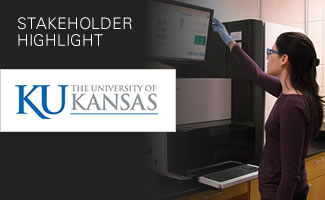
Microbial communities are everywhere: in the soil, in water, and in us. Understanding their structure and function can provide insights applicable to water quality, energy, agriculture, and human health. A new research project at the University of Kansas, making use of new resources at the Lawrence campus, seeks to advance our knowledge of the planet’s smallest organisms.
Laura Gardner, assistant director of KU’s Genome Sequencing Core, is shown with the lab’s Illumina HiSeq 2500 instrumentation. KU photo by Gary Webber.
“KU has great expertise in molecular biosciences and genomic sequencing,” says Belinda Sturm, associate professor of civil, environmental and architectural engineering. “The center we’re forming will enhance our ability to study and analyze the microbiomes that live in the body. This is a very hot area of research right now, because it has so many applications.”
Sturm is leading a five-member team that received a two-year, $300,000 KU Strategic Initiative Grant in January. It’s a diverse group that includes the Kansas Biological Survey and four academic departments. The internal grant program aims to achieve goals laid out in KU’s Bold Aspirations strategic plan, by addressing significant global challenges in four theme areas: Sustaining the Planet, Powering the World; Promoting Well-Being, Finding Cures; Building Communities, Expanding Opportunities; and Harnessing Information, Multiplying Knowledge. KU has awarded nearly $4.4 million since the program began 2012.
Sturm’s project is made possible by recent infrastructure investments at KU. The Center for Molecular Analysis of Disease Pathways, formed in 2012 with a five-year, $11 million grant from the National Institutes of Health (NIH), contains a state-of-the-art Genome Sequencing Core Laboratory. In 2013, KU opened the Advanced Computing Facility (ACF), funded by a $4.7 million NIH grant. The new ACF infrastructure can support 24 times more high-performance computing power than existed previously. Together, these new resources provide the tools needed for large and complex projects. Also important, KU’s core facilities are available to non-KU researchers at companies and other universities on a contract basis.
“Every microbial community is unique and contains mixed populations,” says Sturm. “With the Illumina equipment in the Genome Sequencing Core Laboratory, plus the ACF, we will develop KU’s capacity to sort and interpret the enormous sequencing sets obtained for each sample. This will make us even more competitive for future research grants.”